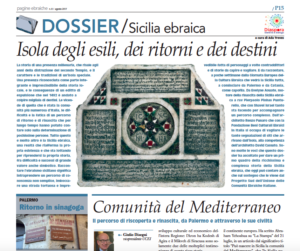European Day of Jewish Culture – Asisa, Salomone and the Others: Kicked Out
Asisa is a woman from Trapani (Sicily). She is Samuele Sala’s wife, who is actually one of the richest bankers of Sicily. Her husband converts in 1492, but she doesn’t. She refuses to become a Christian and she decides to leave the island with her son Sadone, who is 11, even if she is pregnant. At the behest of the king’s deputy, a Christian leads her to her place of exile and supports her until the day of labor. When she delivers, the baby is given back to his father, so that he can raise him once baptized.
Salomone Bas is a doctor from Palermo. He runs the hospital of Bivona, which is a village surrounded by the mountain chain of Monti Sicani, where before the expulsion a giudecca and a synagogue could be found. Fifteen years before the decree of expulsion, Salomone converts to Chistianity and decides to be named Gabriel Zavatteri. After a number of proceedings and tortures, he is released to the secular arm and sentenced to be burnt at the stake in a square of Palermo, which is known as Piazza Martina nowadays.
Stories like Asisa’s, Salomone’s and others’ like them have been analyzed by Angela Scandallato, a teacher of History and Philosophy who managed to become a member of the Italian Association for Jewish Studies and also of the European Association for Jewish Studies in Oxford, thanks to her research on the history of the Jews in Sicily. According to what Scandallato explains, “around 1475, a sharp increase of attacks on Jewish districts and synagogues was registered throughout the island. The Jews from Sicily, who had been ordered to show a red wheel as a distinctive mark, were depicted as rabid dogs, cruel people, dirty loan sharks. The decree of expulsion of 1492 is the result of those decades of tension, persecution and massacres, which mostly occurred in Noto and Modica with tragic consequences”.
In that age, the Franciscans and the Dominicans were those who incited the Christians’ souls. To give an example, this explains why the Jews from Marsala were stoned on Saint Stephen Day with the purpose of commemorating the first Christian martyr’s stoning in a symbolic way. All this happened in a city where a half of the inhabitants of that period belonged to the Jewish community, a reality that already existed in Romans time, as certified by a dozen of lanterns with menorahs dating back to the late imperial age and now displayed at the public archeology museum. With respect to the dreadful expulsion and to the speculation about the seizure of assets for those who didn’t convert, Mrs Scandallato also talks about the case of the Jews from Cammarata. Actually, they accuse the Baron and the local employees of taking their own properties away and imprisoning them in the synagogue. Archive sources speak for themselves:
“… undi non sulum non haviani la sufficienza ddi lu cibu, ma non usando di patirisi chi li bisugnau fari la evacuazioni di lu corpu in quillu medesimo loco”.
Archives: deposits of memories through which we can still learn a lot about the Jews in Sicily. “I made my research in the most important cities’ notary archives in Sicily, in the State Archives of Palermo, Rome, Naples, in the Vatican Library and in Spain, in Barcelona and in the Crown of Aragon Archive”, clarifies Angela Scandallato. And for those who want to deepen the history of the Jews in Sicily, “The Jews in Sicily” (Brill, 1997-2010) is provided: eighteen volumes about historical documentaries by professor Shiomo Simonshon, already president of the University of Tel Aviv. This book series has given rise to a monograph, translated both into Italian and into English, which is called “Tra Sicilia e Cariddi”. It is the story of the Jews in Sicily (Viella, 2011) and it is based on 40.000 archival documents, mostly unpublished.
*Translation made by Anna Pagetti, student at the Advanced School for Interpreters and Translators of Trieste University, intern at the newspaper office of the Union of the Italian Jewish Communities. This article was originally published in Pagine Ebraiche special section “Jewish Sicily”, edited by Ada Treves.

